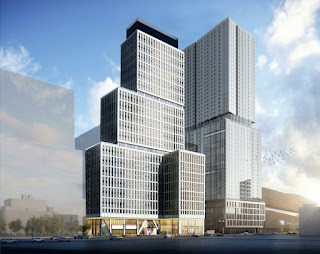Developer: B5 tower won't rise until Spring 2023, finish 2025; next rely on (unresolved) 421-a replacement; →more doubts re 2025 affordable housing deadline
Atlantic Yards/Pacific Park is moving ahead, belatedly, with plans to build a platform over the first of two railyard blocks, which will support three towers--but there are still significant clouds over the potential progress.
Last night, a representative of developer Greenland USA appeared at an online meeting of the North Prospect Heights Association (NPHA), mainly to talk about the coming changes to neighborhood traffic and pedestrian flow (separate article coming) from construction at the first block of the MTA's Vanderbilt Yard, between Atlantic Avenue and Pacific Street and Sixth and Carlton avenues.
That means construction of a platform and the start of the first of three towers, B5, at the western end of that block.
It was a rare public appearance by a Greenland representative at a neighborhood meeting, separate from the bi-monthly public meetings hosted by Empire State Development (ESD), the state authority that oversees/shepherds the project.
 |
| At far left, B4, already built. Then: B5, B6, & B7 |
Notably, there are no firm plans yet to build beyond the first of six railyard towers, given doubts about the renewal or revision of the state's 421-a tax break.
And even if it's revised, that hardly means simultaneous construction of three towers.
Affordable housing deadline
So, I conclude, there's even less chance that the developers can meet the obligation to start and complete 877 more affordable apartments by a May 31, 2025 deadline, after which they face onerous $2,000/month fines for eact missing unit.
That likely means--despite previous assurances that the deadline would be met--an effort to revise the deadline with the gubernatorially-controlled ESD, which has long been solicitous of the developers. (A previous ESD head had brought up the notion of a "legislative fix" for 421-a.)
That could come--I speculate--as part of a plan to add more housing, and affordable housing, to the project with the pending Site 5 project.
That involves a long simmering plan to transfer bulk from the unbuilt B1 tower, approved to loom over the arena at the intersection of Atlantic and Flatbush avenues, to Site 5 across Flatbush, longtime home to Modell's and P.C. Richard, enabling a far larger tower (or towers) than the 250-foot, 440,000 square foot approved building.
Or--who knows--perhaps the developers would seek sufficient city and state subsidies to build one or more "100% affordable" buildings, which would be economically viable without the tax break.
What's coming?
Though Solish, whose firm controls nearly all of master developer Greenland Forest City Partners, distributed an image (top right) of the buildout of that first railyard block, with three towers rising, that plan is hardly guaranteed.
 |
| B5, center-left, plus (built) B4. Dattner Architects |
(The B5 image at right appeared in a Department of Buildings, or DOB, filing, but was not distributed last night.)
The platform should start in June, Solish said, pending LIRR and Department of Buildings (DOB) approvals; that seems a slight delay, given that the most recent Construction Update indicated it could start by this week.
The first phase of the platform should take three years, he said, which means projected completion in mid-2025.
B5 won't go vertical until Spring 2023, he said, and should take two years to build. The platform does not need to be finished for tower construction to start; platform work will start near the B5 site and move west to east. A significant amount of precursor work has been completed, as indicated by concrete and rebar in the photos below.
The other two buildings, he said, rely on the renewal or replacement of the 421-a tax break.
 |
| Looking east from Sixth Ave. to B5 parcel |
The current program allows developers to qualify for the tax break while including 30% affordable housing--better described as, income-linked housing--aimed solely at middle-income households earning 130% of Area Median Income, or AMI, or well above six figures.
That means rents potentially above $3,000 even for a studio. B5, as currently planned, would have 682 apartments, so about 205 income-targeted units.
Developer on 421-a
Solish appeared solicitous, and interacted cordially with NPHA members, saying he'd be "happy to try to answer any questions you may have about the project or what's going on."The first question went to state Sen. Jabari Brisport, a member of the Democratic Socialists of America and an avowed opponent of 421-a. He asked Solish about the timeline.
Solish called 421-a "a critical piece of developing mixed-income, multifamily affordable housing," so if the program lapses, is not renewed, or the replacement is radically different, the developers have to reevaluate.
Developer resistance
I posted what I considered to be two fairly boilerplate questions in the chat: what was the timeline for B5, and did they expect to get foundations in place to qualify for current 421-a benefits?
 |
| Looking west from Carlton Ave. along Atlantic |
"We always hold all these meetings as public meetings," Krashes said.
When I private-messaged him in chat to ask whether he really wasn't going to address the tower's timeline, Solish spoke to the group: "I already answered how long will it take B5 to build."
 |
| Eastern block of the railyard |

Comments
Post a Comment